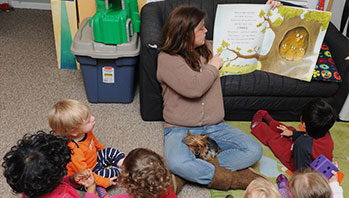- color
- darkest
- dragon
- lighter
- lightest
- mix
- shade
MA Standards:
Literature/RL.PK.MA.1: With prompting and support, ask and answer questions about a story or a poem read aloud.
Literature/RL.PK.MA.6: With prompting and support, “read” the illustrations in a picture book by describing a character or place depicted, or by telling how a sequence of events unfolds.
Literature/RL.PK.MA.9: With prompting and support, make connections between a story or poem and one’s own experiences.
Head Start Outcomes:
Literacy Knowledge/Book Appreciation and Knowledge: Asks and answers questions and makes comments about print materials.
PreK Learning Guidelines:
English Language Arts/Reading and Literature 6: Listen to a wide variety of age appropriate literature read aloud.
English Language Arts/Reading and Literature 10: Engage actively in read-aloud activities by asking questions, offering ideas, predicting or retelling important parts of a story or informational book.
Read Together: Red Is a Dragon #1

© Commonwealth of Massachusetts, Department of Early Education and Care (Jennifer Waddell photographer). All rights reserved.
STEM Key Concepts: There are many different colors; Two or more colors can be combined to make a new color
ELA Focus Skills: Concepts of Print; Making Connections; Parts of a Book; Speaking and Listening, Story Comprehension; Vocabulary
Hold up a copy of Red Is a Dragon by Roseanne Thong. Explain that the book mentions things from the Chinese culture that they might not recognize. Talk about how every culture has things specific to people in that culture and that reading and learning about them will help us know the traditions a little bit better.
- If you have Asian children in your class, it would be a good opportunity to ask them if they are familiar with any of the things mentioned in the book. If so, have them talk about the images after reading.
Before You Read
Read aloud the title and author/illustrator. Then point to the dragon’s eyes and ask questions such as,
- What color are the dragon’s eyes?
- Why do you think the illustrator used red and orange to make the eyes?
- Do you think the dragon is scary? Discuss how colors can sometimes make a picture scary. Place small red circles over the orange center of the eyes to see if the color changes how children feel about the dragon. Do you think the dragon is less scary with red eyes?
- Then have children talk about the different shades of red in the dragon.
As You Read
Pause after reading a page and have children talk about the various items that are the color mentioned in the text, for example ask,
- Watermelon page: Point out the melon and the lychees mentioned in the text, then ask, What other things are red? What shades of red?
- Toad page: Point out the toad and the bottle gourds mentioned in the text, then ask, Can you point to (or name) something green that is lighter than the toad?
- The world is a rainbow page: Have children name objects and the object's color.
After You Read
Return to the last spread of the story and reread the text: “The world is a rainbow for us to explore/What colors are waiting outside your door?” Say,
- I wonder what the author means when she says “The world is a rainbow. Let’s take a look outside and see if we can understand what she means.
- Discuss all the colors children see outdoors.
Take It Further: Introduce children to the glossary. Turn to the glossary and tell children that some books have information following the story that helps you understand some of the things in the story. Read a word you have discussed (i.e., lychee) and find the page in the book where it is introduced. Read the page aloud. Then turn to the glossary and show children how you can use the glossary to help children understand unfamiliar words in the text.
English Language Learners: Invite children to talk about objects and colors that are common in their home cultures.
